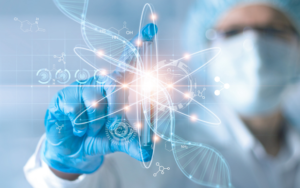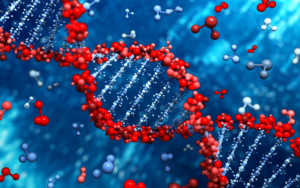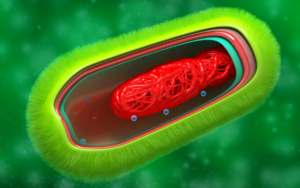Chromosomes, the carriers of genetic information, play a crucial role in the hereditary process. These thread-like structures, located within the nucleus of eukaryotic cells, serve as the blueprint of life for all living organisms. The structure of chromosomes is fascinating, featuring an X-shape during cell division, with two identical sister chromatids joined together by a centromere. Understanding the intricacies of chromosomes is essential to grasp the principles of heredity and genetic diversity.
Each human typically possesses 46 chromosomes, arranged into 23 pairs, including 22 autosomes and one pair of sex chromosomes. The sex chromosomes, X and Y, determine an individual’s gender. Females have two X chromosomes (XX), while males have one X and one Y chromosome (XY). The inheritance of chromosomes follows a specific pattern during fertilization, leading to the transmission of traits from parents to offspring.
Table of Contents
Structure of Chromosomes

Chromosomes are mainly composed of long strands of DNA molecules, which are tightly wound around proteins, forming a complex known as chromatin. The DNA contains genes, the fundamental units of heredity, responsible for passing on specific traits from one generation to the next. These genes are arranged in a linear sequence along the length of the chromosome and carry instructions for building proteins and regulating cellular functions.
The structure of chromosomes becomes particularly visible during cell division. Before cell division occurs, each chromosome undergoes replication, resulting in the formation of two identical sister chromatids connected by the centromere. During cell division, the chromatids separate and are distributed into the newly formed daughter cells, ensuring that each cell receives a complete set of chromosomes.
Chromosomes are instrumental in creating genetic diversity within a population. Mutations, changes in the DNA sequence, can lead to genetic variations, some of which may confer advantageous traits. These beneficial traits offer a survival advantage and contribute to the process of evolution, shaping the characteristics of future generations.
Studying the structure of chromosomes and their organization provides valuable insights into various genetic disorders and inherited diseases. Changes or abnormalities in chromosome structure can lead to chromosomal disorders, such as Down syndrome, Turner syndrome, or Klinefelter syndrome, which have significant impacts on an individual’s development and health.
Function of Chromosomes

Chromosomes, the genetic architects of life, serve multiple vital functions within the cell, influencing various aspects of heredity, development, and evolution. Understanding the functions of chromosomes is essential to unraveling the complexities of genetics and the intricate mechanisms that drive life processes. Here are some key points highlighting the functions of chromosomes:
1. Cell Division and Chromosomes
During cell division, chromosomes undergo intricate processes to ensure the accurate distribution of genetic material to new cells. The sister chromatids separate, and each daughter cell receives an identical set of chromosomes.
2. Chromosomes and Genetic Disorder
Abnormalities in chromosome structure or number can lead to genetic disorders. Conditions like Down syndrome, caused by the presence of an extra chromosome 21, highlight the delicate balance required for proper chromosomal function.
3. Role of Chromosomes in Sex Determination
Chromosomes also govern an individual’s sex. The presence of either an X or Y chromosome in humans determines whether an individual is biologically male (XY) or female (XX).
4. Linkage and Recombination
Chromosomes can exhibit linkage, where genes close together on the same chromosome tend to be inherited together. Recombination, the exchange of genetic material between homologous chromosomes during meiosis, contributes to genetic diversity.
5. Chromosomes and Evolution
Through the process of natural selection, advantageous genetic variations carried by chromosomes provide a survival advantage to certain individuals, leading to the evolution of species over time.
6. Chromosomes and Cancer
Chromosome abnormalities, such as translocations or deletions, are implicated in various cancers. Understanding these alterations is crucial for cancer diagnosis and treatment.
7. Epigenetics and Chromosomes
Epigenetic modifications can influence gene expression without altering the underlying DNA sequence, playing a vital role in chromosomal regulation and heredity.
8. Mitochondrial Chromosomes
In addition to nuclear chromosomes, mitochondria, the cell’s powerhouses, carry their own set of small circular chromosomes, inherited solely from the mother.
9. Role of Telomeres
Telomeres, protective caps at the ends of chromosomes, prevent the loss of genetic material during cell division and play a crucial role in cellular aging.
10. Chromosome Mapping and Genome Sequencing
Advances in technology have enabled scientists to map and sequence entire genomes, facilitating the study of individual chromosomes and their functions.
11. Chromosomes and Genetic Engineering
The manipulation of chromosomes has opened up new possibilities in genetic engineering, allowing for the insertion or removal of specific genes to achieve desired traits.
12. Chromosomes and Embryonic Development
During embryonic development, chromosomes guide the differentiation and specialization of cells, shaping the overall structure of the growing organism.
13. Chromosomes and Genetic Diversity
Chromosomal recombination during sexual reproduction leads to increased genetic diversity, enhancing a species’ ability to adapt to changing environments.
14. Chromosomes and Gene Regulation
Chromosomes play a crucial role in gene regulation, determining which genes are active or silent in a cell, leading to specialized cell types with distinct functions.
15. Chromosomes and Biotechnology
Chromosomes are instrumental in biotechnology applications, such as cloning and gene editing, revolutionizing medical research and agriculture.
16. Chromosome Abnormalities and Reproductive Health
Chromosomal abnormalities can impact fertility and pregnancy outcomes, underscoring the importance of genetic testing in reproductive health.
17. Chromosomes and the Human Genome Project
The Human Genome Project, completed in 2003, unlocked the sequence of all human chromosomes, revolutionizing our understanding of human genetics and diseases.
18. Chromosomes and Personalized Medicine
The study of chromosomes and their functions has paved the way for personalized medicine, tailoring treatments based on an individual’s unique genetic makeup for better health outcomes.
19. Chromosomes and Personalized Medicine
Chromosomes actively participate in gene expression, where the genetic information encoded in genes is transcribed into RNA molecules and translated into proteins. This complex process regulates cellular functions and influences an organism’s phenotype.
20. Chromosomes and Environmental Adaptation
Chromosomal adaptations in response to environmental changes occur over long periods through natural selection. Certain genetic variations carried by chromosomes confer advantages in specific environments, enabling species to thrive in diverse ecological niches.
21. Chromosomes and Genetic Testing
Genetic testing, which analyzes chromosomes and their contents, is a powerful tool in diagnosing inherited genetic disorders and identifying carriers of certain genetic traits.
22. Chromosomes and Reproductive Strategies
In some species, chromosome numbers and structures play a role in determining reproductive strategies, influencing mating behaviors and reproductive success.
23. Chromosomes and Epigenetic Inheritance
Recent research suggests that certain epigenetic modifications on chromosomes may be inherited from one generation to the next, potentially influencing gene expression patterns in offspring.
24. Chromosomes and Cell Differentiation
During development, chromosomes direct the differentiation of stem cells into various specialized cell types, forming tissues and organs with distinct functions.
25. Chromosomes and Hybridization
When individuals from different species interbreed, their chromosomes interact, leading to hybrid offspring. The study of hybrid chromosomes sheds light on evolutionary processes and species relationships.
26. Chromosomes and Genetic Disorders
Besides chromosomal abnormalities, mutations in specific genes located on chromosomes can cause genetic disorders, such as cystic fibrosis or sickle cell anemia.
27. Chromosomes and Chromatin Remodeling
Chromosomes exist in varying states of compaction known as chromatin. Chromatin remodeling is a dynamic process that regulates gene accessibility, affecting gene expression patterns and cellular functions.
28. Chromosomes and Chromosomal Inversions
Chromosomal inversions, where a segment of a chromosome is reversed in orientation, can lead to genetic diversity and adaptation in populations, potentially promoting speciation.
29. Chromosomes and Genomic Imprinting
In some regions of chromosomes, certain genes may be silenced depending on their parental origin, a phenomenon known as genomic imprinting. This process plays a crucial role in embryonic development and growth regulation.
30. Chromosomes and Sex-Linked Traits
Sex-linked traits, controlled by genes on the sex chromosomes, exhibit distinct inheritance patterns, often showing higher prevalence in one sex than the other.
31. Chromosomes and Biomedical Research
Chromosomes are integral to biomedical research, providing insights into disease mechanisms, drug targets, and potential therapies for various genetic disorders.
32. Chromosomes and Evolutionary Conservation
Certain regions of chromosomes are remarkably conserved across different species, indicating their essential roles in fundamental biological processes shared throughout evolutionary history.
33. Chromosomes and Population Genetics
The study of chromosome variation within populations provides valuable information about migration patterns, genetic diversity, and evolutionary history.
34. Chromosomes and Aging
Accumulated damage to chromosomes over time contributes to cellular aging and age-related diseases, highlighting the importance of chromosome stability in maintaining health.
35. Chromosomes and Molecular Genetics
Molecular genetics, which investigates the structure and function of chromosomes at the molecular level, has revolutionized our understanding of genetics and heredity.
36. Chromosomes and Genomic Rearrangements
Genomic rearrangements, such as duplications, deletions, and translocations of chromosomal segments, can lead to genetic variation and may play a role in adaptation and speciation.
37. Chromosomes and Genomic Rearrangements
Telomerase, an enzyme that maintains the length of telomeres, is involved in cellular aging and cancer. Chromosomes’ telomeres are crucial in regulating telomerase activity and ensuring cell stability.
38. Chromosomes and Gene Regulation during Development
Throughout embryonic development, different sets of genes are turned on and off in a tightly regulated manner, orchestrated by the chromosomes. This process guides the formation of distinct cell types and tissues.
39. Chromosomes and Transcription Factors
Transcription factors, proteins that bind to specific DNA sequences, regulate gene expression. Chromosomes serve as platforms for these factors to initiate or inhibit transcription.
40. Chromosomes and Hormone Responsiveness
Certain chromosomes carry genes responsible for hormone receptors, influencing an individual’s response to hormones like estrogen, testosterone, and thyroid hormones.
41. Chromosomes and Chromosomal Evolution
Chromosomal changes, such as inversions, translocations, and fusions, contribute to chromosomal evolution, impacting species diversification and adaptation.
42. Chromosomes and Immunoglobulin Diversity
Chromosomal rearrangements in immune cells generate a vast array of immunoglobulins (antibodies), ensuring our immune system can recognize and combat diverse pathogens.
43. Chromosomes and Speciation
Chromosomal differences between populations can contribute to reproductive isolation and speciation, as changes in chromosome number or structure can lead to hybrid sterility or inviability.
44. Chromosomes and X-Inactivation
In female mammals, one of the two X chromosomes is randomly inactivated in each cell during early development, compensating for the double gene dosage of females compared to males.
45. Chromosomes and Meiotic Drive
Meiotic drive refers to the biased transmission of certain chromosomes during gamete formation, affecting their inheritance frequencies in populations.
46. Chromosomes and Chromosomal Territories
Within the cell nucleus, chromosomes occupy specific territories, and their spatial arrangement influences gene expression and cellular function.
47. Chromosomes and B Chromosomes
In some organisms, “B chromosomes” exist as extra, dispensable chromosomes with varying effects on an individual’s phenotype and reproduction.
48. Chromosomes and Chromosome Painting
Chromosome painting is a technique used to visualize specific chromosomal regions, aiding in the study of chromosomal abnormalities and evolutionary relationships.
49. Chromosomes and Chromosome Territories
Within the cell nucleus, chromosomes occupy specific territories, and their spatial arrangement influences gene expression and cellular function.
50. Chromosomes and Nuclear Organization
Chromosomes play a key role in the three-dimensional organization of the cell nucleus, impacting gene regulation and genome stability.
51. Chromosomes and Non-Coding RNAs
Non-coding RNAs, transcribed from specific chromosomal regions, participate in various regulatory processes, such as gene silencing and epigenetic modifications.
52. Chromosomes and Chromosome Fragility
Certain chromosomal regions are prone to fragility, making them susceptible to breaks and rearrangements, which can contribute to genetic diseases.
53. Chromosomes and Centromere Function
The centromere, a specialized region on chromosomes, ensures proper segregation during cell division, maintaining genomic stability.
54. Chromosomes and Centromere Function
Sister chromatid cohesion, facilitated by proteins bound to chromosomes, ensures accurate chromosome segregation during cell division.
55. Chromosomes and Chromosome Elimination
In certain organisms, chromosomes undergo programmed elimination during development, enabling species-specific adaptations and reproductive strategies.
56. Chromosomes and Chromosome Polymorphism
Chromosome polymorphism refers to natural variations in chromosome structures within a population, providing insights into genetic diversity and evolutionary dynamics.
57. Chromosomes and Chromosome Repair Mechanisms
Cells have sophisticated repair mechanisms to fix damaged chromosomes, safeguarding genome integrity and preventing mutations.
58. Chromosomes and Chromosome Repair Mechanisms
Chromosomal abnormalities, such as translocations and amplifications, are hallmark features of many cancer types, contributing to oncogenesis.
59. Chromosomes and Chromosome Evolution in Plants
Plant genomes exhibit unique chromosomal evolution, including whole-genome duplications, contributing to plant diversity and adaptation.
60. Chromosomes and Chromosome Territories
Within the cell nucleus, chromosomes occupy specific territories, and their spatial arrangement influences gene expression and cellular function.
61. Chromosomes and Mitotic Spindle Formation
During cell division, chromosomes interact with the mitotic spindle, a protein structure essential for accurate chromosome segregation.
62. Chromosomes and Chromosome Size
Chromosome size varies among species, and understanding the significance of this variation sheds light on evolutionary processes.
63. Chromosomes and Chromosomal Packaging
Chromosomes undergo dynamic changes in packaging during the cell cycle, affecting gene accessibility and cell function.
64. Chromosomes and Chromosome Replication
The process of chromosome replication ensures faithful transmission of genetic information from one cell generation to the next.
65. Chromosomes and Chromosome Diversity in Sex Determination
Sex determination mechanisms vary across species, involving different chromosomes and genetic cues.
66. Chromosomes and Chromosome Number Variations
Chromosome number variations, like aneuploidy, can lead to developmental disorders and impact fertility.
67. Chromosomes and Chromosome Interactions
Chromosomes interact with one another, forming higher-order structures and influencing gene regulation.
68. Chromosomes and Genome Evolution
Comparative genomics, analyzing chromosome structure and content across species, helps uncover patterns of genome evolution and speciation.
Overall, chromosomes stand as the remarkable architects of heredity, playing a central role in transmitting the blueprint of life from one generation to the next. Their intricate structure, characterized by X-shaped forms and composed of DNA and specialized proteins, ensures the faithful replication and distribution of genetic information during cell division. Through the dynamic process of gene expression and regulation, chromosomes dictate an individual’s traits, characteristics, and even their response to the environment and diseases. From determining an organism’s sex to fostering genetic diversity and influencing evolutionary processes, chromosomes are the gatekeepers of life’s complexity.
Understanding the functions and significance of chromosomes enhances our grasp of genetics, evolutionary biology, and medical research. As researchers continue to unlock the secrets of chromosomes, novel insights into heredity and disease mechanisms emerge, paving the way for groundbreaking advancements in personalized medicine and biotechnology. By exploring the captivating world of chromosomes, we gain a deeper appreciation for the interconnectedness of all living beings and the intricate processes that shape the diversity of life on our planet.




